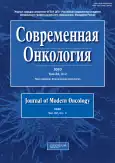Accompanying therapy in oncohematological patients with secondary immunodeficiency
- Authors: Babicheva L.G.1, Poddubnaya I.V.1
-
Affiliations:
- Russian Medical Academy of Continuous Professional Education
- Issue: Vol 22, No 2 (2020)
- Pages: 89-97
- Section: Review
- URL: https://journals.rcsi.science/1815-1434/article/view/34957
- DOI: https://doi.org/10.26442/18151434.2020.2.200127
- ID: 34957
Cite item
Full Text
Abstract
Actuality. The inability of a person’s immune system to withstand foreign antigenic aggression is called immunodeficiency. More than 1/2 of all cases of secondary immunodeficiency (SID) in the world are occupied by hemoblastosis and, in a greater degree, the therapy, accompanied by the immunosuppression. Due to the expansion of the arsenal of new targeted drugs for the treatment of oncohematological diseases affecting different parts of the immune system, to increasingly frequent use of autologous and especially allogeneic hematopoietic cell transplantation, the prevalence and the frequency of SID are inexorably increasing. Timely diagnosis of SID should be the starting point of the management of oncohematological patients to reduce the incidence of infectious complications and, as a result, case fatality rate. Monitoring is based on assessing risk factors and identifying the category of patients requiring active preventive measures before they develop severe infection. Elimination of the main cause of SID development is the preferred option for the prevention of the infectious complications. However, in case of multiple myeloma, chronic lymphocytic leukemia and other oncohematological diseases, this option is often impossible. Therefore, active accompanying therapy is necessary for this category of patients, in particular immunoglobulin (Ig) replacement therapy. Main clinical communities are currently in the process of updating their guidelines and recommendations on using Ig replacement therapy in patients with hemoblastosis accompanied severe recurrent infections; after ineffective antibiotic treatment; with a proven inadequate specific antibody response; IgG<4 g/l. Numerous cohort, observational and randomized trials showed the significant reduction in the number of infectious complications in oncohematological patients on using long-term (not less than 10–12 months) intravenous Ig replacement therapy. The lack of attention of oncologists and hematologists to the early diagnosis and prevention of these conditions leads to the increase in the number of infectious complications with all the consequences such as worsen treatment results and increase mortality among oncohematological patients.
Conclusion. There is a real need to raise awareness among physicians and patients, to use screening and better management of the group of patients with increased risk of SID, and preventive use of intravenous Ig to reduce the incidence of infectious complications and active accompanying therapy aimed at reducing infection-related mortality.
Full Text
##article.viewOnOriginalSite##About the authors
Lali G. Babicheva
Russian Medical Academy of Continuous Professional Education
Author for correspondence.
Email: lalibabicheva@mail.ru
ORCID iD: 0000-0001-8290-5564
Cand. Sci. (Med.)
Russian Federation, MoscowIrina V. Poddubnaya
Russian Medical Academy of Continuous Professional Education
Email: lalibabicheva@mail.ru
ORCID iD: 0000-0002-0995-1801
D. Sci. (Med.), Prof., Acad. RAS
Russian Federation, MoscowReferences
- Patel SY, Carbone J, Jolles S. The Expanding Field of Secondary Antibody Deficiency: Causes, Diagnosis, and Management. Front Immunol 2019; 10: 33. doi: 10.3389/fimmu.2019.00033
- Cancer Stat Facts: Chronic Lymphocytic Leukemia. National Cancer Institute. https://seer.cancer.gov/statfacts/html/clyl.html
- Dhalla F, Lucas M, Schuh A et al. Antibody deficiency secondary to chronic lymphocytic leukemia: should patients be treated with prophylactic replacement immunoglobulin? J Clin Immunol 2014; 34: 277–82.
- Seppänen M. Immunoglobulin G treatment of secondary immunodeficiencies in the era of novel therapies. Clin Exp Immunol 2014; 178 (Suppl. 1): 10–3.
- Tete SM, Bijl M, Sahota SS, Bos NA. Immune defects in the risk of infection and response to vaccination in monoclonal gammopathy of undetermined significance and multiple myeloma. Front Immunol 2014; 5: 257.
- Blimark C, Holmberg E et al. Multiple myeloma and infections: a population-based study on 9253 multiple myeloma patients. Haematologica 2015; 100: 107–13.
- Na I‐K, Buckland M, Agostini C. Current clinical practice and challenges in the management of secondary immunodeficiency in hematological malignancies. Eur J Haematol 2019.
- Parmar S, Patel K, Pinilla-Ibarz J. Ibrutinib (imbruvica): a novel targeted therapy for chronic lymphocytic leukemia. P T 2014; 39: 483–519.
- Hasegawa T, Aisa Y, Shimazaki K et al. Cytomegalovirus reactivation in patients with multiple myeloma. Eur J Haematol 2016; 96 (1): 78–82.
- Lavi N, Okasha D, Sabo E et al. Severe cytomegalovirus enterocolitis developing following daratumumab exposure in three patients with multiple myeloma. Eur J Haematol 2018. doi: 10.1111/ejh.13164. [Epub ahead of print]
- Kaplan B, Bonagura VR. Secondary Hypogammaglobulinemia: An Increasingly Recognized Complication of Treatment with Immunomodulators and After Solid Organ Transplantation. Immunol Allergy Clin North Am 2019; 39 (1): 31–47. doi: 10.1016/j.iac.2018.08.005
- Maus MV, Grupp SA, Porter DL, June CH. Antibody-modified T cells: CARstake the front seat for hematologic malignancies. Blood 2014; 123: 2625–35.
- Christou EAA, Giardino G, Worth A, Ladomenou F. Risk factors predisposing to the development of hypogammaglobulinemia and infections post-Rituximab. Int Rev Immunol 2017; 36: 352–9.
- Vacca A, Melaccio A, Sportelli A et al. Subcutaneous immunoglobulins in patients with multiple myeloma and secondary hypogammaglobulinemia: a randomized trial. Clin Immunol 2018; 191: 110–5. doi: 10.1016/j.clim.2017.11.014
- Slawik HR, Plath M. 7th International Immunoglobulin Conference, April 3–5, 2014, Interlaken, Switzerland; 16th Biennial Meeting of the European Society of Immunodeficiencies, Oct. 29 – Nov. 1, 2014, Prague, Czech Republic.
- European Medicines Agency. Guideline on Core SmPC for Human Normal Immunoglobulin for Intravenous Administration (IVIg): EMA (2018). https://www.ema.europa.eu/documents/scientificguideline/guideline-core-smpc-human-normal-immunoglobulinintravenous-administration-ivig-rev-5_en.pdf
- Srivastava S, Wood P. Secondary antibody deficiency – causes and approach to diagnosis. Clin Med 2016; 16 (6): 571–6.
- Бабичева Л.Г., Поддубная И.В. Вторичные иммунодефициты в онкогематологии. Учебное пособие. М., 2019. [Babicheva L.G., Poddubnaya I.V. Secondary immunodeficiencies in oncohematology. Tutorial. Moscow, 2019 (in Russian).]
- Sun А, Teschnerand W et al. Improving Patient Tolerability in Immunoglobulin Treatment: Focus on Stabilizer Effects. Expert Rev Clin Immunol 2013; 9 (6): 577–87.
- Bolli R et al. L-Proline reduces IgG dimer content and enhances the stability of intravenous immunoglobulin solutions. Biologicals 2010; 38 (1): 150–7.
- Siani B et al. Isoagglutinin Reduction in Human Immunoglobulin Products by Donor Screening. Biol Ther 2014; 4: 15–26.
Supplementary files















